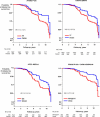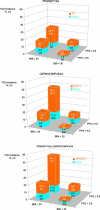Genetic prediction of future type 2 diabetes - PubMed (original) (raw)
Clinical Trial
Genetic prediction of future type 2 diabetes
Valeriya Lyssenko et al. PLoS Med. 2005.
Abstract
Background: Type 2 diabetes (T2D) is a multifactorial disease in which environmental triggers interact with genetic variants in the predisposition to the disease. A number of common variants have been associated with T2D but our knowledge of their ability to predict T2D prospectively is limited.
Methods and findings: By using a Cox proportional hazard model, common variants in the PPARG (P12A), CAPN10 (SNP43 and 44), KCNJ11 (E23K), UCP2 (-866G>A), and IRS1 (G972R) genes were studied for their ability to predict T2D in 2,293 individuals participating in the Botnia study in Finland. After a median follow-up of 6 y, 132 (6%) persons developed T2D. The hazard ratio for risk of developing T2D was 1.7 (95% confidence interval [CI] 1.1-2.7) for the PPARG PP genotype, 1.5 (95% CI 1.0-2.2) for the CAPN10 SNP44 TT genotype, and 2.6 (95% CI 1.5-4.5) for the combination of PPARG and CAPN10 risk genotypes. In individuals with fasting plasma glucose > or = 5.6 mmol/l and body mass index > or = 30 kg/m(2), the hazard ratio increased to 21.2 (95% CI 8.7-51.4) for the combination of the PPARG PP and CAPN10 SNP43/44 GG/TT genotypes as compared to those with the low-risk genotypes with normal fasting plasma glucose and body mass index < 30 kg/m(2).
Conclusion: We demonstrate in a large prospective study that variants in the PPARG and CAPN10 genes predict future T2D. Genetic testing might become a future approach to identify individuals at risk of developing T2D.
Conflict of interest statement
Competing Interests: LG is a member of the editorial board of PLoS Medicine.
Figures
Figure 1. Unadjusted Kaplan–Meier Diabetes-Free Survival Probability Curves
Curves for different carriers of PPARG P12A (PP versus PA/AA), CAPN10 SNP44 (TT versus TC/CC), UCP2 −866 G/A (GG versus GA/AA), and the combination of PPARG and CAPN10 SNP43/44 (PP/GG/TT versus other). _y-_Axis shows probability of diabetes-free survival time. _x_-Axis shows follow-up time in years. The HR of developing T2D in different genotype carriers obtained from Cox proportional hazards regression stratified on sex and adjusted for age, BMI, and family history of diabetes with robust variance estimate is shown (see also Table 3).
Figure 2. The Effects of Risk Genotypes of the PPARG P12A Polymorphism (PP), the Combination of CAPN10 SNP43/44 (GG/TT), and the Combination of PPARG and CAPN10 SNP43/44 (PP/GG/TT) Together with FPG and BMI for the Risk of Developing T2D
_y_-Axis denotes incident diabetes estimated as the proportion (percent) of participants who developed diabetes during the follow-up period in the groups with each risk factor defined as risk genotype, elevated FPG (≥5.6 mmol/l), and high BMI (≥30 kg/m2). The absolute number of individuals who developed diabetes in the groups with each risk factor is given within the bars (in parentheses) and in Table S2. The incidence of T2D was significantly increased in carriers of the risk PP genotype, GG/TT genotypes, and PP/GG/TT genotypes with elevated FPG and high BMI as compared with individuals carrying low risk genotypes without risk factors (χ2 test, p < 0.001).
Figure 3. The Effect of Insulin Resistance Together with the Risk Genotype of the PPARG P12A Polymorphism on Risk of Developing T2D
_y_-Axis denotes HR and its 95% CI. _x_-Axis denotes increase in insulin resistance estimated as HOMAIR.
Similar articles
- Association of the E23K polymorphism in the KCNJ11 gene with gestational diabetes mellitus.
Shaat N, Ekelund M, Lernmark A, Ivarsson S, Almgren P, Berntorp K, Groop L. Shaat N, et al. Diabetologia. 2005 Dec;48(12):2544-51. doi: 10.1007/s00125-005-0035-0. Epub 2005 Nov 17. Diabetologia. 2005. PMID: 16320083 - Association of IRS1, CAPN10, and PPARG gene polymorphisms with type 2 diabetes mellitus in the high-risk population of Hyderabad, India.
Kommoju UJ, Maruda J, Kadarkarai Samy S, Irgam K, Kotla JP, Reddy BM. Kommoju UJ, et al. J Diabetes. 2014 Nov;6(6):564-73. doi: 10.1111/1753-0407.12142. Epub 2014 Apr 3. J Diabetes. 2014. PMID: 24612564 - A replication study of the IRS1, CAPN10, TCF7L2, and PPARG gene polymorphisms associated with type 2 diabetes in two different populations of Mexico.
Martínez-Gómez LE, Cruz M, Martínez-Nava GA, Madrid-Marina V, Parra E, García-Mena J, Espinoza-Rojo M, Estrada-Velasco BI, Piza-Roman LF, Aguilera P, Burguete-García AI. Martínez-Gómez LE, et al. Ann Hum Genet. 2011 Sep;75(5):612-20. doi: 10.1111/j.1469-1809.2011.00668.x. Ann Hum Genet. 2011. PMID: 21834909 - Is genetic testing useful to predict type 2 diabetes?
Vassy JL, Meigs JB. Vassy JL, et al. Best Pract Res Clin Endocrinol Metab. 2012 Apr;26(2):189-201. doi: 10.1016/j.beem.2011.09.002. Best Pract Res Clin Endocrinol Metab. 2012. PMID: 22498248 Free PMC article. Review. - Gene-lifestyle interplay in type 2 diabetes.
Franks PW, Merino J. Franks PW, et al. Curr Opin Genet Dev. 2018 Jun;50:35-40. doi: 10.1016/j.gde.2018.02.001. Epub 2018 Feb 20. Curr Opin Genet Dev. 2018. PMID: 29459268 Free PMC article. Review.
Cited by
- The KCNJ11 E23K polymorphism and progression of glycaemia in Southern Chinese: a long-term prospective study.
Cheung CY, Tso AW, Cheung BM, Xu A, Fong CH, Ong KL, Law LS, Wat NM, Janus ED, Sham PC, Lam KS. Cheung CY, et al. PLoS One. 2011;6(12):e28598. doi: 10.1371/journal.pone.0028598. Epub 2011 Dec 5. PLoS One. 2011. PMID: 22163043 Free PMC article. - Predictive genetic testing for type 2 diabetes.
Janssens AC, Gwinn M, Valdez R, Narayan KM, Khoury MJ. Janssens AC, et al. BMJ. 2006 Sep 9;333(7567):509-10. doi: 10.1136/bmj.38953.598947.80. BMJ. 2006. PMID: 16960189 Free PMC article. No abstract available. - Type 2 diabetes: new genes, new understanding.
Prokopenko I, McCarthy MI, Lindgren CM. Prokopenko I, et al. Trends Genet. 2008 Dec;24(12):613-21. doi: 10.1016/j.tig.2008.09.004. Epub 2008 Oct 25. Trends Genet. 2008. PMID: 18952314 Free PMC article. Review. - Risk prediction of prevalent diabetes in a Swiss population using a weighted genetic score--the CoLaus Study.
Lin X, Song K, Lim N, Yuan X, Johnson T, Abderrahmani A, Vollenweider P, Stirnadel H, Sundseth SS, Lai E, Burns DK, Middleton LT, Roses AD, Matthews PM, Waeber G, Cardon L, Waterworth DM, Mooser V. Lin X, et al. Diabetologia. 2009 Apr;52(4):600-8. doi: 10.1007/s00125-008-1254-y. Epub 2009 Jan 13. Diabetologia. 2009. PMID: 19139842 - Genome-based prediction of common diseases: methodological considerations for future research.
Janssens AC, van Duijn CM. Janssens AC, et al. Genome Med. 2009 Feb 18;1(2):20. doi: 10.1186/gm20. Genome Med. 2009. PMID: 19341491 Free PMC article.
References
- Zimmet P, Alberti KG, Shaw J. Global and societal implications of the diabetes epidemic. Nature. 2001;414:782–787. - PubMed
- Bonadonna RC. Alterations of glucose metabolism in type 2 diabetes mellitus. An overview. Rev Endocr Metab Disord. 2004;5:89–97. - PubMed
- Chan JM, Rimm EB, Colditz GA, Stampfer MJ, Willett WC. Obesity, fat distribution, and weight gain as risk factors for clinical diabetes in men. Diabetes Care. 1994;17:961–969. - PubMed
- Altshuler D, Hirschhorn JN, Klannemark M, Lindgren CM, Vohl MC, et al. The common PPARgamma Pro12Ala polymorphism is associated with decreased risk of type 2 diabetes. Nat Genet. 2000;26:76–80. - PubMed
Publication types
MeSH terms
Substances
LinkOut - more resources
Full Text Sources
Other Literature Sources
Medical
Miscellaneous


